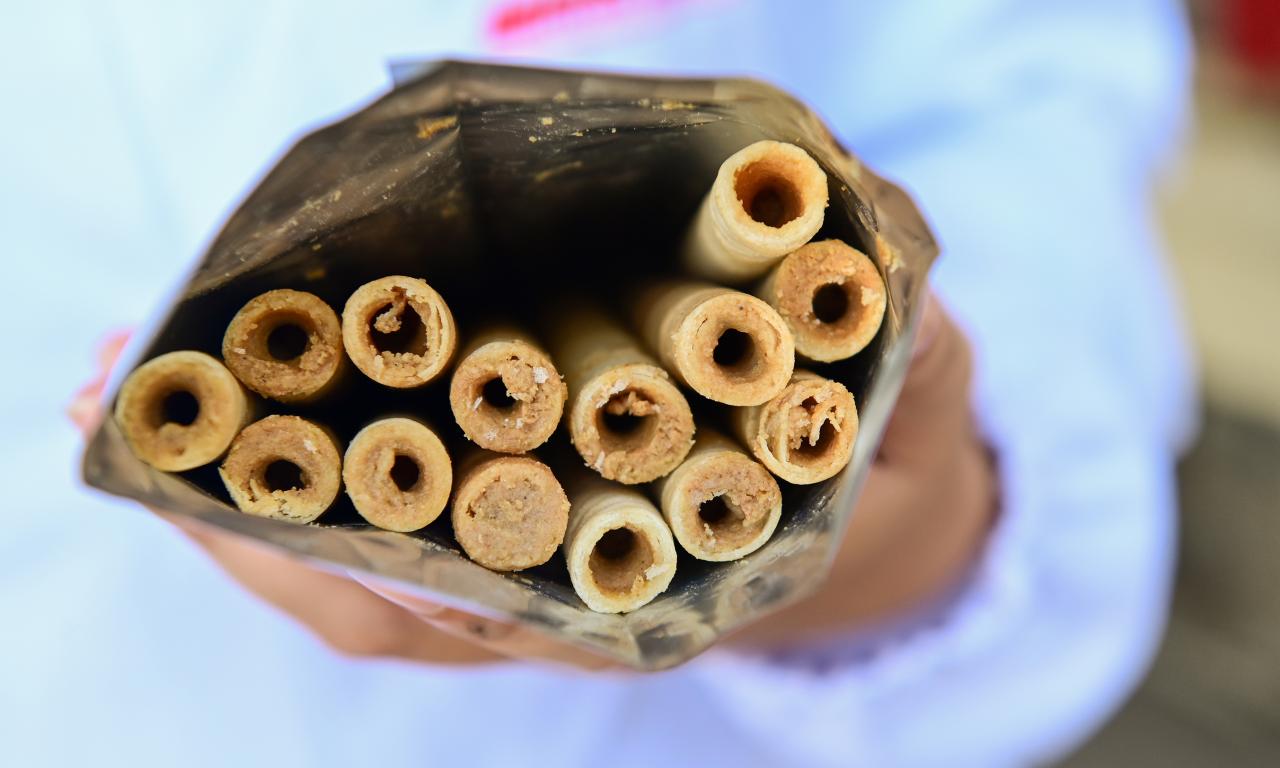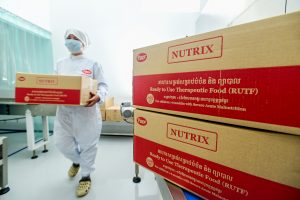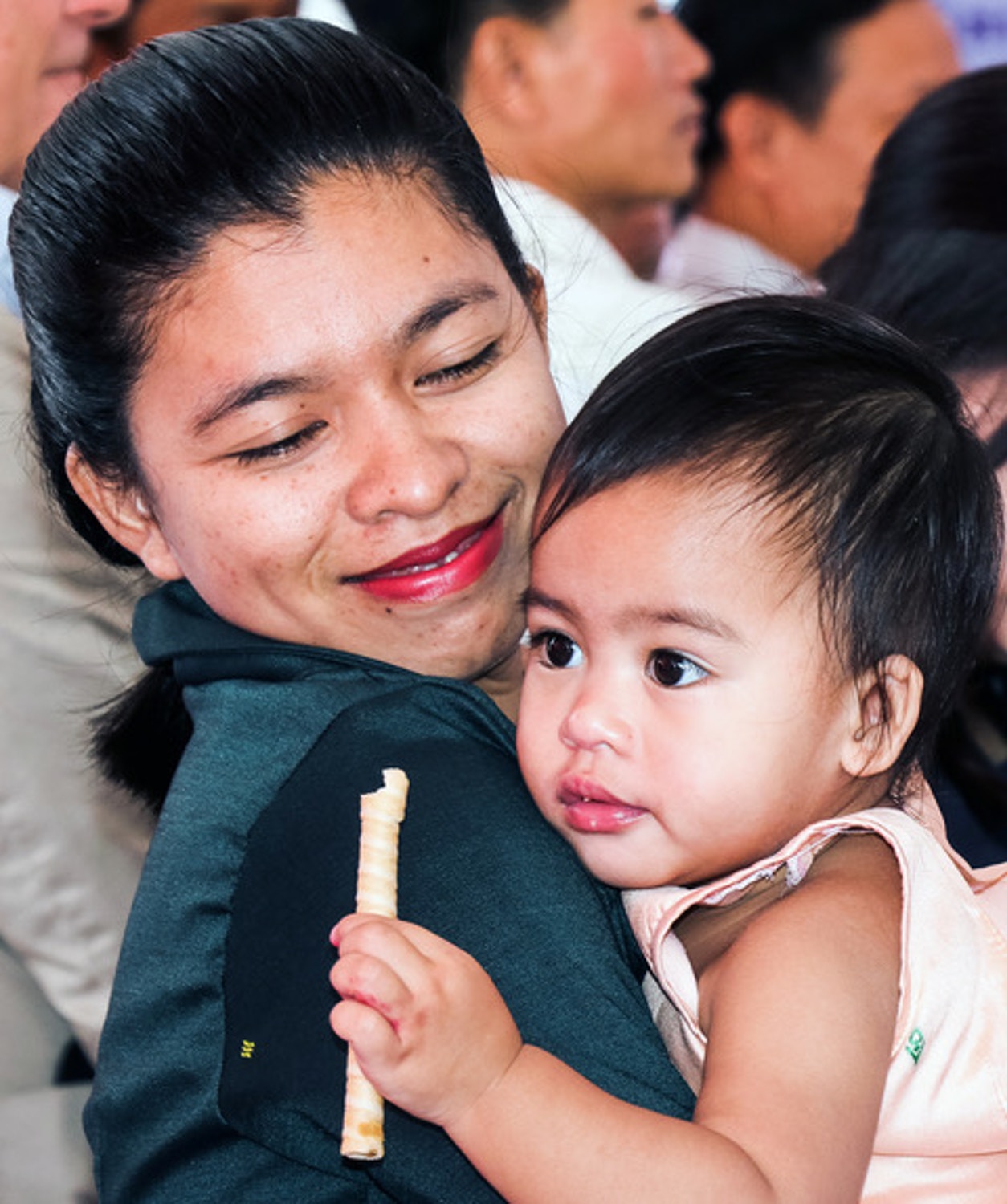
Lyndon Paul offers a tube-shaped wafer for me to try.
It fractures as I bite, releasing a yummy ooze of slightly sweet, slightly savory filling.
“It’s like… confectionary,” I tell him, as we sit in the forecourt of Danish Care Foods, in a leafy suburb of Cambodia’s capital Phnom Penh.
Lyndon looks pleased with my assessment.
If I hadn’t already known, I wouldn’t have guessed the magic ingredient was fish. And I definitely wouldn’t have guessed that this unassuming snack is classed as a medicine for treating malnourished children here in Cambodia.


It’s the result of years of work by Lyndon and his team at Vissot, Danish Care Foods, partners at UNICEF, the French National Research Institute for Sustainable Development (IRD), the University of Copenhagen, and the Department of Fisheries Post-Harvest Technologies and Quality Control (DFPTQ), Fisheries Administration, Cambodia - plus a grant from the Bill & Melinda Gates Foundation.
It all began in 2013 when IRD approached Lyndon - then a product designer for Vissot, a local health food company. IRD wanted to develop therapeutic food for children suffering from malnutrition in Cambodia and were keen to use local ingredients, particularly fish. Was Lyndon interested in getting involved? Most definitely.
At the time, the Cambodian government relied on imported therapeutic foods made from a “classic mix” of milk powder, wheat flour, oat flour, and soy protein. While these foods are nutrient-rich, they weren’t very popular. They tended to congeal in the mouth, becoming chewy and hard to swallow. The food industry calls this “mouthfeel”. No matter how nutritious, attractive, convenient or tasty a food product, mouthfeel can make or break it.
IRD and their partners at UNICEF wanted to make a new, more palatable product. By using local ingredients, they hoped to make them cheaper too.
Lyndon agreed that using fish as a key ingredient was an obvious choice: They were abundant in much of Cambodia, with the country’s Tonle Sap lake producing huge quantities each year. Fish were also a mainstay of local diets and were well-known for their health benefits.
Starting with a frying pan in a small kitchen, the Vissot team experimented with different recipes using trey real - Siamese mud carp predominantly, and other freshwater small fish that are very cheap and easy to source at certain times of the year in Cambodia. Importantly, they used the whole fish - minus the gut content - to ensure the greatest concentration of micronutrients in the paste.


There is plenty of research showing the nutritional value of whole, small fish. With high concentrations of vitamins A, B12, C and D, calcium, iron, zinc, fatty acids, selenium, and protein, they contain many of the nutrients missing from the diets of many children in Cambodia.
The use of whole, small fish is also championed by research organizations like WorldFish, which is working to develop fish-based products for vulnerable communities. Dr Shakuntala Thilsted, Program Leader, Value Chains and Nutrition, WorldFish, tells me that whole, small fish are a nutritional powerhouse. “If consumed whole, they can be called a ‘superfood’,” she says. The organization has supported women’s groups in Bangladesh, Timor-Leste and Zambia to process small fish into nutritious products such as chutneys and powders, which are used to fortify household meals.
Back in Cambodia, the challenge for the Vissot team was slightly different. Rather than a complementary food, they wanted to produce a stand-alone, fish-based, therapeutic food that children could snack on without the need for preparation.
The team managed to source sufficient quantities of Siamese mud carp and other small fish from fishers on the Tonle Sap and transported them to Phnom Penh for processing. Next, they cleaned, dried and baked them before feeding them into an extruder – a machine that grinds the fish at a high temperature to kill bacteria. Lyndon tells me the heat can also cause a loss of nutrients, so you have to find the sweet spot, temperature-wise.
After months and months of trials, the result was a simple brown paste.


It was “very fishy,” Lyndon chuckles. By which he means too fishy: At times, the smell was overpowering, he says. The team tweaked the recipe to try to reduce the odor, with some success.
They called the paste Num Trey (Fish Snack).
Unfortunately, nobody liked it. It was still too fishy, plus the idea of eating fish paste off a spoon wasn’t a hit with the children.
Then came the epiphany moment.
“We had the idea to bring the food closer to a well-known local snack called Num Phom,” says Lyndon. These were wafers made from a batter of rice, coconut milk and sugar and rolled into a hollow tube. “It’s available on almost all street corners and convenience stores here. It’s a really popular snack food.”
Inspired by Num Phom, Lyndon and the team made their own batter and pumped the wafers full of a blend of their fish paste, along with rice, mung bean, soybean, canola (rapeseed) oil, and vegetable shortening as an additional source of fat.
The combination of ingredients masked the fishy smell and resulted in - as I discovered - a deliciously moreish snack that was both sweet and savory. Crucially, there was no stickiness while eating it – meaning it passed the mouthfeel test too. Fortunately, it wasn’t just me who found them so agreeable: “It was a major breakthrough,” Lyndon tells me. “The kids loved them.”
Things moved quickly from there.
IRD, UNICEF, the University of Copenhagen and DFPTQ set up tasting and efficacy studies at local schools, hospitals, and nearby communities. They also worked closely to bring the snack up to the required international and national nutritional standards.
The final product was called Nutrix.
In 2018, Lyndon set up Danish Care Foods with a Danish business partner, Christian Philip Unmack. Established as a local pharmaceutical social enterprise, Danish Care Foods was able to invest in new machinery and began large-scale production of Nutrix while retaining close ties with the product developer, Vissot.
The same year, Vissot received a USD 100,000 grant from the Bill & Melinda Gates Foundation to support the supply of fish for Nutrix, with the aim of reducing the overall production cost.
Vissot built a cleaning station on the banks of the Tonle Sap, in nearby Kandal Province to receive, process and dry small fish and send them to Danish Care Foods in Phnom Penh. It also worked with local fishers involved in two USAID-funded projects: NOURISH, led by Save the Children, and Rice Field Fisheries Enhancement, led by WorldFish, training fishers in Siem Reap and Pursat provinces on best practices for safely handling the fish prior to transport.
The work resulted in Nutrix being around 20 percent cheaper than imported therapeutic foods.
The following year, Nutrix was officially recognized by the Cambodian government as a medicine, making it the world’s first fish-based, ready-to-use, therapeutic food. It was soon introduced to feeding programs by the government, UNICEF, and other NGOs, reaching thousands of children suffering from malnutrition in the country.
It was all going incredibly well. And then the rains failed at the end of 2019.
Usually, the Tonle Sap roughly doubles in size during the rainy season, spreading across a huge floodplain and providing an enormous habitat - and breeding ground - for many small fish species.
“Without enough rain, there wasn’t enough flooding, which meant the fish weren’t migrating as they normally would,” says Lyndon. There was so little to catch that many fishers simply didn’t take their boats out for days or weeks on end. While Vissot was able to source Siamese mud carp and other small fish species from fishers further afield, the prices were unsustainably high.
Never one to shy away from a challenge, Lyndon is now looking at other ways to ensure a steady supply of fish so that production of Nutrix can continue. One option is to raise fish in ponds, rather than rely on a potentially unpredictable supply of wild-caught fish. This would almost certainly require a change in fish species, which would have a series of knock-on effects through the Nutrix production system, but it’s under consideration.
All the while, international interest in Nutrix has surged. Lyndon tells there have been inquiries from people from the government, the private sector, NGOs and development agencies in Laos, Indonesia, Nepal, Bangladesh, and India, keen to establish similar production facilities and support malnutrition programs there. “It means that despite all the challenges, at least we know we’re doing something right!”.